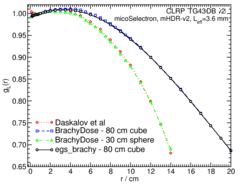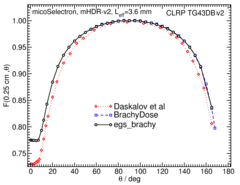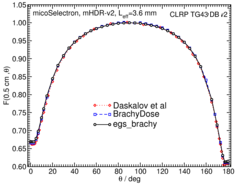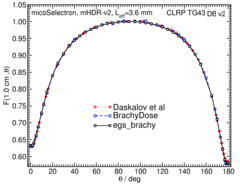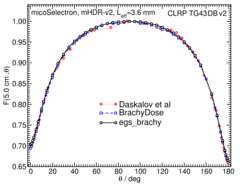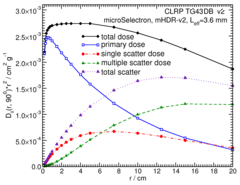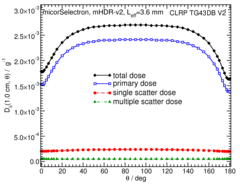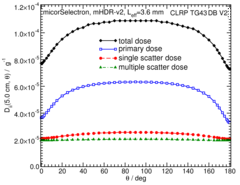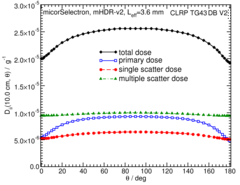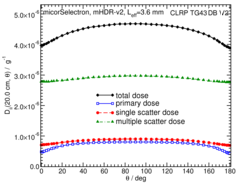
Source Description:
Dimensions for the microSelectron v2 are taken from the study by Daskalov et al 1,2 and Perez-Calatayud et al 3. The microSelectron consists of a 3.60 mm long 192Ir core with a diameter of 0.65 mm enclosed in a 0.90 mm diameter AISI 316L stainless steel capsule (density 8.06 g/cm3). The Ir core was modelled as a 3.48 mm long cylindrical section attached to two 0.265 mm radius, 0.06 mm long 45o conical sections to approximate the rounded ends of the real source. The tip of the encapsulation is modelled as a 0.45 mm radius hemi-sphere with its center shifted 1.55 mm (previous database: 1.65 mm) from the center of the source. The end of the encapsulation attached to the cable is modelled as a 0.15 mm thick conical section (half angle of 33.7o) starting 2.35 mm (previous database: 1.2 mm) from the center of the source. Attached to the conical section is a 2 mm long and 0.7 mm diameter section of AISI 316L stainless steel cable with a density of 4.81 g/cm3. The active length of this source is 3.60 mm. The mean photon energy calculated on the surface of the source is 361.12 keV with statistical uncertainties < 0.01%.
Dose Rate Constant - Λ :
Dose-rate constants, Λ , are calculated by dividing the dose to water per history in a (0.1 mm)3 voxel centered on the reference position, (1 cm,Π/2), in the 80x80x80 cm3 water phantom, by the air-kerma strength per history factor (scored in vacuo). Air kerma per history is always calculated using a tracklength estimator in a 10x10x0.05 cm3 air voxel located in vacuo on the transverse axis 100 cm away from the source and then corrected (kr2 = 1.00217) for the lateral and thickness dimensions of the scoring voxel to give the air kerma per history on the central axis at a point 100 cm from the source’s mid-point as described in our previous study4,5. Low-energy photons emitted from the source encapsulation are suppressed in the air-kerma calculations by discarding all photons with energy less than 10 keV (i.e. PCUT set to 10 keV in EGSnrc). egs_brachy uncertainties are only statistical uncertainties (k=1). Two previous results calculated Λ at a reference distance of 0.2 cm rather than the usual 1 cm as this includes electron transport effects.
| Author | Method | Λ (cGy h-1 U-1) | Abs. Uncertainty |
| Safigholi et al 6 |
10x10x0.05 cm3 voxel at 100 cm With electron transport |
1.1090 1.1084 |
0.0002 0.0012 |
|
Taylor, Rogers 7 |
10x10x0.05 cm3 voxel at 100 cm |
1.109 | 0.002 |
| Taylor, Rogers 7 | r o = 0.2 cm / voxel at 100 cm | 22.73 | 0.02 |
| Daskalov et al 1, 2 | MCPT (extrap) | 1.108 | 0.001 |
| Wang, Li 8 | r o = 0.2 cm / voxel at 100 cm | 22.75 | 0.03 |
| Granero et al 9 | MCNP5 | 1.1102 | 0.0004 |
| Granero et al 9 | PENELOPE2008 | 1.1100 | 0.0004 |
| Granero et al 9 | GEANT4 | 1.1119 | 0.0005 |
| Papagiannis et al 10 | Monte Carlo | 1.109 | 0.005 |
| Perez-Calatayud et al 3 | Consensus value (HEBD) | 1.109 |
0.012 |
| Lopez et al 10 | Penelope(with e transport) | 1.111 | 0.002 |
Radial dose function - g(r):
The radial dose function, g(r), is calculated using both line and point source geometry functions and tabulated at 36 different radial distances ranging from 0.2 cm to 20 cm.
Anisotropy function - F(r,θ):
Anisotropy functions are calculated using the line source approximation and tabulated at 12 radii from 0.25 cm to 20 cm and 47 unique polar angles with a resolution of 5° or better. The anisotropy factor, φan (r), is calculated by integrating the solid angle weighted dose rate over 0°≤ ϑ ≤ 180°.
Along-Away Dose Data:
Along-away dose data are tabulated at 16 away distances from 0 cm to 20 cm and 31 along points from -20 cm to 20 cm. Doses are normalized to SK, the air kerma strength.
Primary and Scatter Separated (PSS) Dose Data: Dii (r,θ):
Primary and Scatter Separated (PSS) dose data are tabulated at 12 radii from 0.25 cm to 20 cm and 47 unique polar angles with a resolution of 5° or better. High resolution (Δr = 1 mm, ΔΘ = 1°) primary scatter dose data are also available in .csv files. For the purposes of these calculations, any photon escaping the source encapsulation is considered a primary. Only photons which scatter within the phantom are counted in the scatter tallies. Doses are normalized to the total photon energy escaping the encapsulation. The "ii" subscript labeled in the Dii(r, θ) represent the total scatter as Dto(r, θ), the primary photons as Dpr(r, θ), the single scatter photon as Dss(r, θ), and the multiple scatter photons as Dms (r, θ).
Click images for higher res versionsHigh resolution (1mm/1°) Tabulated D ii (r,θ) data in .csv format: Zipped archive
Photon Energy Spectra
Photon energy spectra generated by the source model are calculated using egs_brachy surface count scoring option to get the spectrum on the surface of the source. The relative counts here are the counts per 1 keV bin normalized to 1 count total in the spectrum. The MC calculations have a statistical uncertainty less than 0.001% on the mean energy. The spectrum data are available in xmgrace format below.
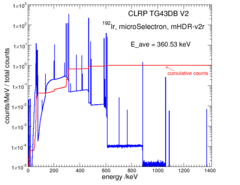
Energy weighted photon spectrum data: xmgrace
Tabulated data:
Tabulated data are available in .xlsx format: Excel
References:
2. G. M. Daskalov, Erratum: "Monte Carlo-aided dosimetry of a new high dose-rate brachytherapy source" [Med. Phys. 25, 2200-2208 (1998)], Med. Phys., 27 , 1999-1999, 2000
7. R. E. P. Taylor, D. W. O. Rogers, EGSnrc Monte Carlo calculated dosimetry parameters for 192Ir and 169Yb brachytherapy sources, Med. Phys., 35 , 4933 - 4944, 2008
8. Ruqing Wang, X. Allen Li, Dose characterization in the near-source region for two high dose rate brachytherapy sources, Med. Phys., 29 , 1678-1686, 2002
